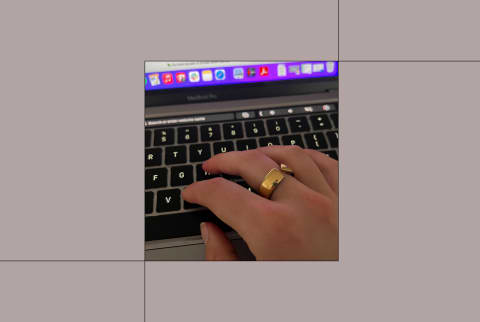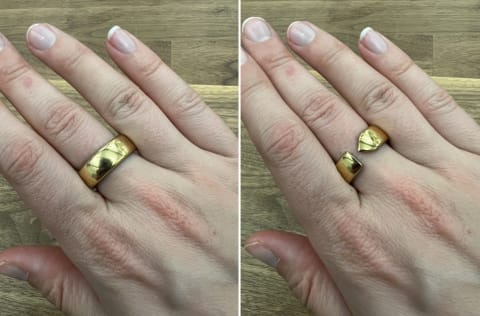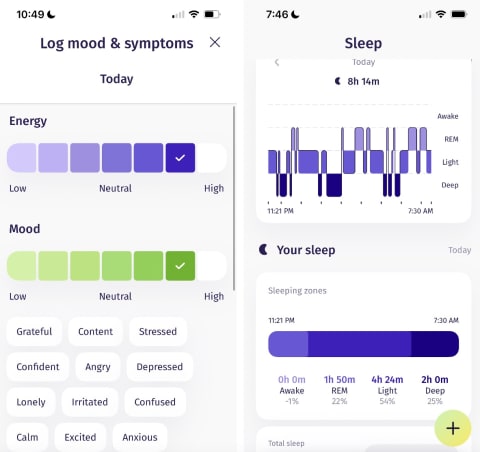Advertisement
Evie Ring Review: I Wore The New Smart Ring For Women For 1 Month


It's an all-too-common experience for women who wear fitness trackers: Around the same time every month, your watch or ring alerts you that your temperature is up, your sleep is suffering, and your activity level is lower than usual. Time to rest up, the tracker says, as you might be getting sick.
In reality, these changes are caused by the natural hormonal fluctuations that happen during a woman's cycle and are not necessarily cause for concern. The (male-dominated) health tech industry just hasn't figured out how to account for them yet. Enter: Evie Ring, a new smart ring designed specifically for women.
I've been using the Evie ring for the last month, and comparing the data it serves me to my Apple Watch: Here are the pros and cons of the ring, its special benefits for women, and how it stacks up against other trackers.
What is the Evie ring?
Evie is a smart ring that's designed for women (though, you don't have to identify as a woman to wear it). In addition to the typical metrics you'd expect from a health wearable like heart rate, sleep, and step count, Evie allows women to track their menstrual cycle, mood, and energy—and how they shift alongside hormonal changes.
The team at Movano Health, Evie's parent company, made the device after identifying a need in the market. "Women have been underserved by health care," Stacy Salvi, Movano's VP of strategy, tells me on a call. "Historically, there's been a lack of research on what's going on within women's bodies, particularly given the amount that women's bodies change over time."
She notes that most existing health trackers have been designed by men who (rightfully so) built something they would want to use—and hoped that just making the device smaller would make it suitable for women too.
Evie is the first health tracker specifically designed to monitor women's menstrual cycle, mood, and energy from the jump. "It was definitely very refreshing to make something that puts women's needs first," Salvi says.
The ring comes in sizes 5-12 and is available in gold, rose gold, and silver colorways. It costs $269 (FSA/HSA eligible) and comes with a charger and subscription to the accompanying Evie app (currently only available on iOS).
Editor's note:
What are its women-specific features?
When designing the ring, Evie consulted hundreds of women to learn about the type of metrics they'd be most interested in. Through that process, they homed in on a few features that could improve the wearable experience for women:
- Open design: Evie doesn't form a complete circle—the ring features an opening that is straight on one end and angular on the other. "It's is very slightly flexible," says Salvi. "And that's highly intentional given that our hands tend to swell over the course of a day or over a month." She explains that making the ring comfortable for women (anecdotally, our fingers tend to swell more than men's) was important to help them wear the product as long as possible—and therefore, get the most accurate data from it.
- Period tracking & personalized cycle recommendations: You can use the Evie App to manually track when you're having your period, how heavy your menstrual flow is, and any PMS symptoms or vaginal discharge you're experiencing. After a few months of tracking, the app should provide insights into your fertility window and ovulation date. (Note: I have not been using the ring for long enough to see how accurate these are.) Salvi explains that the ring should soon be able to make personalized recommendations depending on where a woman is in her cycle too. For example, "We noticed that you get more restless sleep during your luteal phase. Here are some things that you can do to help."
- Mood tracking that won't bum you out: The Evie App also features a daily journal feature where you can keep track of your mood and energy levels. While other health trackers have this too, Evie's is laid out slightly differently—for good reason. "We didn't want to do something called 'priming.' Priming describes the idea that when you're faced with a series of words to describe your mood, you may choose the more negative mood," Salvi says. So in addition to providing some words, the journal also allows you to rank your energy and mood on a scale from low to high.
On Evie's website, it also says the ring's data collection is better calibrated to women to account for sex differences in baseline respiratory rate, airway size, etc., though this wasn't immediately clear to me during testing (more on my experience below).
Evie also measures:
- Blood oxygen levels (SpO2) (a measure of how well your body utilizes oxygen)
- Respiration rate (a measure of your lung health and circulation)
- Skin temperature
- Sleep quality (including total sleep time, time awake, and time in REM, light, and deep sleep stages)
- Heart rate variability
- Heart rate and resting heart rate
- Step count
- Activity level and calorie burn
Insider intel on what's next:
My experience wearing it for a month
I first heard about Evie while editing this article about the future of women's health care late last year, and I was eager to get my hands on (in?) an early model.
Once I used Evie's kit to figure out my size, the team set me up with my ring in late January. At first, I had some issues pairing my ring to my phone, but the Evie customer service team was able to help me out, and I was up and running by February.
Right away, I loved the ring's open design. My fingers are usually more swollen when I first wake up, and while my wedding ring feels uncomfortably tight in the morning, the Evie is barely noticeable. At first, I tried wearing it with the open groove on the inside of my finger but found that it would pinch my skin when I lifted weights or carried heavy groceries. Once I turned this side to face outward, the problem went away and I actually preferred the way it looked.

I used the app to set goals for the amount of sleep I wanted to get each night (eight hours) and the number of active minutes I wanted to hit a day (60). When I achieved these goals, the app let me know, which gave me a nice little dopamine hit.
After about four days of using the ring around the clock, I realized that I hadn't charged it. I appreciated the long battery life, and its accompanying portable charging case (which can handle 10 charges without being plugged in) made it easy to juice up on the go.
I got into the groove of checking the app first thing in the morning, mostly to see my heart rate variability during sleep. This is a health metric I'm trying to increase by managing my stress and resting more, and it was nice to have a way to track my progress. I did notice that sometimes the app overestimated the amount of sleep I got and didn't account for all of my midnight wake-ups.
I run a lot, and the ring picked up on this activity on its own. But when I spoke with Movano's CEO, John Mastrototaro, he alerted me that manually "starting" a workout in the app would help the ring take even more accurate data during movement. Once I did, the ring sensors lit up lime green, letting me know that it was taking a consistent heart rate reading.
The daily journal was a nice place to check in with myself, my mood, and my energy levels during the day.
I look forward to continuing to track my period over the next few cycles to give the ring enough data to start making recommendations.
Overall, I've enjoyed wearing the ring over the last month, and it still looks good as new with no scratches or dents.
How it compares to other trackers
I wear an Apple Watch Series 9 during the day, though not at night (I find sleeping in watches uncomfortable). I've also used the Oura ring for sleep tracking on and off over the years. Here's how the Evie compares to these devices, in my experience:
Evie vs. Oura:
- Evie is more comfortable for me to wear to sleep than Oura.
- Oura's data on the amount of time I spend in different sleep cycles seems to be more accurate. It also is easier to assess previous sleep scores and monitor trends over time with Oura.
- I prefer the Evie app's interface to Oura's. It used to stress me out to see a low "readiness score" on Oura after a bad night's sleep. I know some people find these analyses helpful, but I like that Evie just shows me the numbers.
Evie vs. Apple Watch:
- Evie consistently tells me I've taken more steps in the day than Apple Watch. Most days, my step count is around 12-15% higher on Evie. (Salvi, who comes from a smartwatch background, tells me she suspects that watches consistently undercount steps.)
- Apple Watch is better at picking up on my heart rate spikes during workouts. I also think it more accurately measures running distance than Evie based on runs I took wearing both.
- Apple Watch sends a lot of notifications, which I find distracting and usually end up turning off. Evie sends very few notifications, which I appreciate.
In the end, I found the Evie better for some things (HRV readings, step count) than others (heart rate readings during exercise, sleep analysis). That said, it's important to remember that it's a brand-new product. I look forward to seeing how it continues to evolve over time. "It's just going to be more and more helpful as we gain experience with people using it and we run population statistics and analysis," says Mastrototaro.

My favorite things about the Evie—and a few I'd change
All in all, I really love the Evie ring's comfortable, stylish, and durable design. Its long battery life and on-the-go charging capabilities are also a big plus. Wearing it is an unobtrusive way to monitor how I'm tracking toward my movement and HRV goals. Since I've only been using the ring for a month, I haven't really seen its menstrual cycle insights in action, but I appreciate that a wearable company has finally stepped up to the plate to make those more prominent.
I do wish the Evie app made it easier to analyze historical trends and got more granular with its exercise and sleep data collection. I'm probably going to keep using my Apple Watch for workout tracking and Oura ring for nitty-gritty insights on my sleep quality. But I'll keep using Evie because, hey, it's cute, and the promise of discovering how my hormones impact my mood, workouts, and more makes it too exciting to take off.